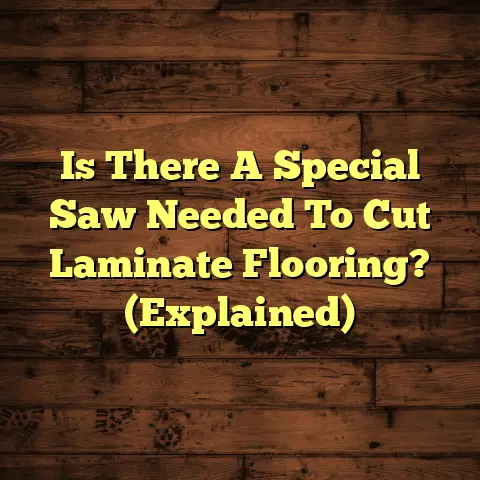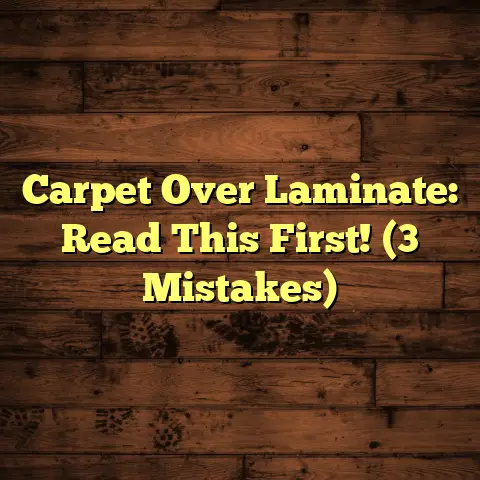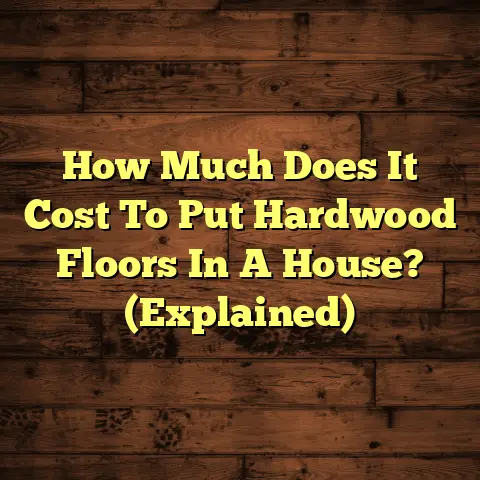Concrete Floor Costs: What to Know? (1 Thing Affects Price!)
(1 Thing Affects Price!)
Let’s talk concrete. I’ve been a flooring contractor for over 15 years, and I’ve seen it all – from cracked tiles to warped wood.But one flooring option that consistently impresses me is concrete. It’s not just grey and industrial anymore; it’s become a design statement.
Think sleek, polished floors in a modern loft or a rustic, stained patio that screams “chill vibes.”
But before you jump in, let’s be real: cost matters. And understanding what drives those costs is crucial.
That’s why I’m writing this – to give you the inside scoop on concrete flooring, demystify the pricing, and highlight the one thing that really impacts your budget.
Ready to dive in? Let’s do it!
The Value of Concrete Flooring
Let’s face it, flooring is a big deal. It’s not just about covering the subfloor; it’s about creating a space that’s functional, beautiful, and reflects your style.
Concrete flooring ticks all those boxes.
-
Durability: Concrete is tough. I’m talking “withstand-a-zillion-kids- running-through-the-house” tough. It resists scratches, dents, and stains better than many other options.
-
Versatility: You might think concrete is just grey, but you’d be wrong. It can be polished to a high shine, stained in a rainbow of colors, stamped with intricate patterns, or sealed for a natural look.
-
Aesthetic Appeal: Concrete can be modern, rustic, industrial, or even glamorous. It all depends on the finish and the design choices you make.
Now, let’s get down to brass tacks: cost. Understanding the costs associated with concrete flooring is essential for any renovation or construction project.
It can seriously impact your budget, so knowing what to expect is half the battle.
We’re going to take a deep dive into the factors that affect concrete floor pricing, but I’m going to zero in on the one key factor that really makes a difference.
Stay tuned!
Section 1: The Basics of Concrete Flooring
Okay, before we get into the nitty-gritty of costs, let’s make sure we’re all on the same page about what concrete flooring actually is.
1. Definition and Types
Simply put, concrete flooring is a floor surface made from, well, concrete! But it’s not just any old concrete slab. It’s often treated, finished, and sealed to create a durable and attractive surface.
Here’s a quick rundown of the most common types of concrete flooring:
-
Polished Concrete: This is where the concrete is mechanically ground and polished with progressively finer grits of diamond abrasives. The result? A super-smooth, glossy surface that’s both beautiful and easy to maintain.
Think of it as the “high-end” option.
-
Stained Concrete: This involves applying a stain to the concrete to add color and depth. You can achieve a wide range of looks, from earthy tones to bold, vibrant hues.
It’s a great way to customize your floor.
-
Stamped Concrete: This is where patterns are pressed into the concrete while it’s still wet. You can mimic the look of brick, stone, tile, or even wood.
It’s perfect for adding texture and visual interest.
-
Sealed Concrete: This is the most basic option, where the concrete is simply sealed with a clear coating to protect it from stains and damage.
It’s a budget-friendly choice that still offers durability.
2. Applications
Concrete flooring isn’t just for industrial spaces anymore. It’s popping up everywhere, from homes to businesses.
Here are some common applications:
-
Residential:
- Basements: Concrete is a great option for basements because it’s resistant to moisture and easy to clean.
- Kitchens: Polished or stained concrete can create a modern and stylish kitchen floor.
- Living Areas: Concrete can add a touch of industrial chic to any living space.
- Patios & Outdoor Spaces: Stamped concrete is perfect for creating beautiful and durable outdoor patios and walkways.
-
Commercial:
- Warehouses: Concrete is the go-to choice for warehouses due to its durability and ability to withstand heavy traffic.
- Retail Spaces: Polished concrete can create a sleek and modern look for retail stores.
- Offices: Concrete can add a touch of sophistication to office spaces.
- Restaurants: Sealed concrete is easy to clean and maintain, making it a great option for restaurants.
Section 2: Cost Breakdown of Concrete Floors
Alright, let’s get down to the numbers. Understanding the cost breakdown of concrete floors is crucial for budgeting your project.
I’m going to break it down into three main categories: materials, labor, and additional costs.
1. Material Costs
The cost of materials will vary depending on the type of concrete flooring you choose, the size of the area you’re covering, and the quality of the materials you use.
Here’s a general idea of what you can expect to pay:
-
Raw Concrete: The cost of raw concrete typically ranges from $100 to $200 per cubic yard. Keep in mind that you’ll need to factor in the cost of delivery.
-
Additives: Additives can improve the strength, durability, and workability of concrete. Expect to pay $10 to $50 per bag, depending on the type of additive.
-
Finishing Products: This includes stains, sealers, polishes, and other products used to finish the concrete. Prices can range from $20 to $100 per gallon, depending on the product.
- Concrete Stain: Water-based stains are generally cheaper, ranging from $20 to $50 per gallon, while acid-based stains can cost $50 to $80 per gallon.
- Concrete Sealers: Acrylic sealers are the most affordable, costing around $30 to $60 per gallon. Polyurethane and epoxy sealers are more expensive, ranging from $60 to $100 per gallon.
- Polishing Compounds: These can cost around $40 to $80 per gallon.
2. Labor Costs
Labor costs can vary widely depending on your location, the complexity of the installation, and the contractor’s expertise.
Generally, you can expect to pay $3 to $10 per square foot for labor. More complex finishes, like polished or stamped concrete, will typically cost more.
Here’s a rough breakdown:
- Basic Sealing: $1 to $3 per square foot.
- Staining: $2 to $5 per square foot.
- Polishing: $3 to $10 per square foot.
- Stamping: $5 to $12 per square foot.
Keep in mind that these are just estimates. It’s always best to get multiple quotes from different contractors to get a more accurate idea of labor costs in your area.
3. Additional Costs
Don’t forget to factor in these additional costs:
-
Site Preparation: This may include removing old flooring, leveling the subfloor, and cleaning the area. Expect to pay $1 to $3 per square foot for site preparation.
-
Disposal of Old Flooring: If you’re removing old flooring, you’ll need to dispose of it properly. Disposal fees can range from $50 to $200, depending on the amount of material.
-
Permits: Depending on your location and the scope of the project, you may need to obtain permits. Permit fees can vary widely, but typically range from $50 to $500.
-
Concrete Delivery: This can range from $75 to $200 depending on the quantity and distance.
Section 3: Location and Its Impact on Costs
Location, location, location! It’s not just a real estate mantra; it applies to concrete flooring costs too.
Let’s explore how your location can impact the price you pay.
1. Geographical Variations
Concrete flooring costs can vary significantly depending on your region. This is due to several factors, including:
-
Labor Availability: Areas with a high demand for skilled concrete contractors may have higher labor costs.
-
Material Sourcing: The cost of concrete and other materials can vary depending on local availability and transportation costs.
-
Local Demand: In areas where concrete flooring is popular, prices may be higher due to increased demand.
For example, I’ve seen prices for polished concrete in major metropolitan areas like New York City or San Francisco be significantly higher than in smaller, more rural areas.
Example:
- Polished Concrete in NYC: $8 – $15 per square foot
- Polished Concrete in Rural Midwest: $5 – $10 per square foot
2. Climate Considerations
Climate can also play a role in concrete flooring costs. In areas with extreme weather conditions, such as very cold or very hot climates, special installation techniques may be required.
For example, in cold climates, you may need to use additives to prevent the concrete from freezing and cracking. In hot climates, you may need to take extra precautions to prevent the concrete from drying out too quickly.
These extra steps can add to the overall cost of the project.
Section 4: The Key Factor Affecting Concrete Floor Pricing: Finish Type
Okay, we’ve covered the basics of concrete flooring, the cost breakdown, and the impact of location. Now, let’s get to the one thing that really drives up the price: the finish type.
1. Explaining the Finish Types
As I mentioned earlier, there are several different types of concrete finishes you can choose from. Each finish has its own unique look and feel, and each comes with its own price tag.
Let’s take a closer look at how each finish affects the overall cost of your concrete floor:
-
Polished Concrete: Polishing concrete is a multi-step process that involves grinding the surface with progressively finer grits of diamond abrasives. This requires specialized equipment and skilled labor, which makes it one of the most expensive options.
-
Stained Concrete: Staining concrete involves applying a stain to the surface to add color and depth. The cost of staining will depend on the type of stain you choose (water-based vs. acid-based) and the number of coats required.
-
Stamped Concrete: Stamping concrete involves pressing patterns into the concrete while it’s still wet. This requires special stamps and tools, as well as skilled labor to ensure the patterns are applied correctly.
-
Sealed Concrete: Sealing concrete is the most basic and affordable option. It simply involves applying a clear sealer to protect the surface from stains and damage.
2. Cost Comparison
To give you a better idea of how finish types affect costs, here’s a comparative analysis with specific price ranges:
| Finish Type | Cost per Square Foot |
|---|---|
| Sealed Concrete | $2 – $5 |
| Stained Concrete | $3 – $7 |
| Polished Concrete | $5 – $15 |
| Stamped Concrete | $8 – $18 |
As you can see, there’s a significant difference in price between the different finish types. Polished and stamped concrete are the most expensive options, while sealed concrete is the most affordable.
For example, a 1000 sq ft floor with polished concrete finish can cost between $5,000 – $15,000 depending on the level of polishing and the contractor.
3. Market Trends
Current trends in concrete flooring finishes can also impact costs. For example, the growing popularity of decorative concrete overlays has led to increased demand and potentially higher prices.
Additionally, the use of eco-friendly finishes and sustainable materials may also add to the cost of your concrete floor. According to a report by Grand View Research, the global green building materials market size was valued at USD 347.7 billion in 2022 and is expected to expand at a compound annual growth rate (CAGR) of 10.8% from 2023 to 2030.
Section 5: Long-term Value and Return on Investment
Okay, so concrete flooring can be a bit pricey upfront, especially if you opt for a high-end finish. But it’s important to consider the long-term value and return on investment.
1. Durability and Longevity
Concrete flooring is incredibly durable and can last for decades with proper maintenance. Unlike carpet, tile, or wood, concrete won’t need to be replaced every few years.
This means you’ll save money in the long run on replacement costs.
2. Energy Efficiency
Concrete has excellent thermal mass, which means it can absorb and store heat. This can help regulate the temperature in your home, reducing your heating and cooling costs.
In the summer, concrete floors can stay cool, reducing the need for air conditioning. In the winter, they can absorb heat from the sun, reducing your heating bills.
According to the Portland Cement Association, concrete floors can reduce heating and cooling costs by up to 20%.
3. Market Appeal
High-quality concrete flooring can increase the value of your property and make it more attractive to potential buyers.
A well-designed concrete floor can add a touch of sophistication and style to any home, making it stand out from the crowd.
Conclusion: Making Informed Decisions
So, there you have it – a comprehensive guide to concrete floor costs. I’ve covered everything from the basics of concrete flooring to the key factors that affect pricing.
Remember, the finish type you choose will have the biggest impact on the overall cost of your project. But it’s important to consider both initial costs and long-term value when making your decision.
Do your research, get multiple quotes from different contractors, and choose a finish that fits your budget and your style.
With a little planning and effort, you can have a beautiful and durable concrete floor that will last for years to come!





